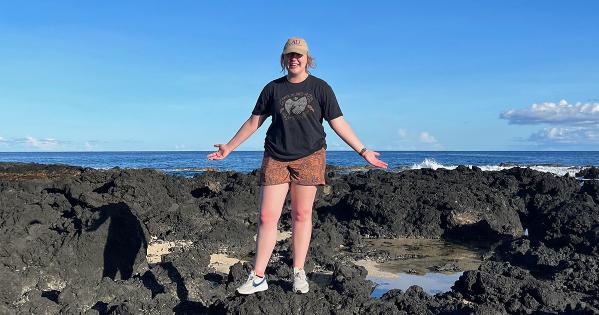Research Protecting Some of World’s Most Threatened Wetlands

Last spring, Nina Mewborne (MS environmental science) was invited to travel to American Samoa on a fieldwork team with Professors Karen Knee and Kiho Kim, University of Hawai`i Professor Henrietta Dulai, and fellow AU student TreVaughn Ellis (BS biology, environmental science minor).
The team’s mission was to determine where and how much pollution is entering Nu`uuli Pala Lagoon, the largest remaining (and most threatened) wetland in American Samoa.
The project used spatial surveys and tidal time series of radon, a natural tracer of groundwater discharge, to map groundwater discharge into the lagoon and reef and determine how it varies in space and time. The team measured concentrations of pollutants (things like nutrients, trace metals, pesticides, pharmaceuticals, and personal care products) and used radium to estimate how quickly the water in the lagoon is replaced by oceanic water.
“Nina was an essential member of our field work team," says Knee. “She waded through mud and kayaked across the lagoon in strong winds to collect water samples, and she always had a positive, helpful attitude.”
The goal was to identify pollution hotspots, calculate how long pollutants remain in lagoon water and reef front, and assess the importance of groundwater and surface water as pathways of pollutant transport. The team is sharing these data with the American Samoa Environmental Protection Agency, the Department of Marine and Wildlife Resources, and other local agencies to inform management decisions as they work to protect the health of the lagoon and reefs. Knowing how pollutants are getting into the lagoon – whether by surface runoff or groundwater, or both — is critical for developing effective mitigation strategies.
Data: Next Steps
After the AU team returned to DC, Mewborne wanted to continue the work. She received a AU STEM Student Summer Research Program award with funding from the NASA District of Columbia Space Grant Consortium (DCSGC) and from the CAS Mathias Research Fellowship, which is allowing her to spend this summer in the lab, analyzing fieldwork findings.
“I am working in lab to analyze data from both the research trip in the wet season (March of 2023 — the trip I was on) as well as data collected during the dry season (August 2022)," Mewborne says. “Data includes radon, radium, nutrients, trace metals, pharmaceuticals, hydrogen + oxygen isotopes, and nitrogen in algae measurements from all around the island and in the lagoon. Once data analysis is complete, locals and government officials will be provided with a report outlining the findings.”
Mewborne is planning to present her research at a poster presentation at the Coastal and Estuarine Research Federation biennial meeting in Portland, Oregon, this November, and she will be the lead author on a journal article about the project.
The Value of Field Work

Mewborne, who earned a BS in environmental science in May 2023, is in American University’s five-year BS/MS environmental science program. She will be graduating with her MS in May 2024 and says that the opportunity to conduct research with faculty members on the American Samoa trip—and spend a summer analyzing it—is invaluable. "It has allowed me to practice a variety of skills and techniques while creating a relationship with mentors, peers, and professors,” she says.
Knee agrees. “Fieldwork is essential to a lot of environmental science research," she says. “It also provides opportunities for scientists at different career stages to work together and build lasting relationships by sharing challenges, adventures, and accomplishments.”
One of the unique aspects of this work, Knee points out, is the opportunity to experience different cultures. “In American Samoa, we could interact with local people and learn about the territory’s history, language, and culture as well as its environmental challenges," she says. “We will continue to work with local environmental agencies to publicize our results, including creating bilingual materials in English and Samoan.”
